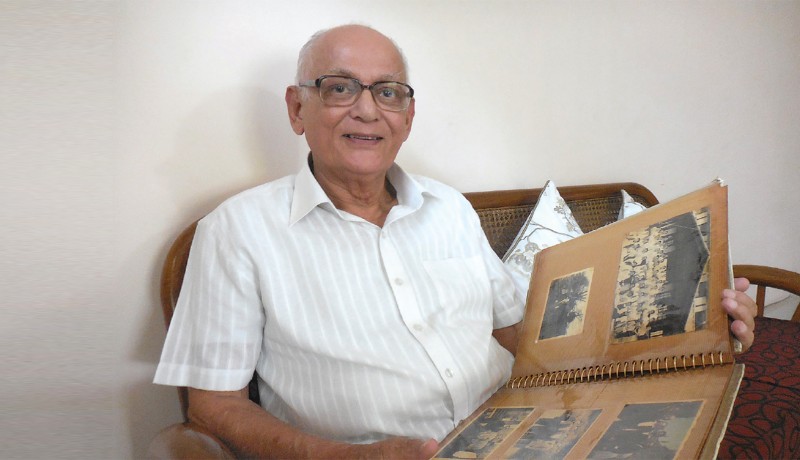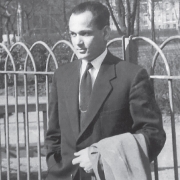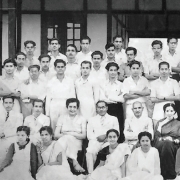
People

A young ‘freedom fighter’ risked it all for his country in Assam. At 88 now, Dr Dulal Borkotoky recalls the fateful event, reports Tapati Baruah Kashyap
For Dr Dulal Chandra Borkotoky, 15 August is a little more special than for most others. Every year, as the anniversary of Indian Independence approaches, the events that led up to that climactic moment of freedom begin to replay like a film reel in his mind.
It is a long and vivid stream of memories, the kind savoured only by people who once lived, breathed and participated in the events that changed the destiny of their country. Dr Borkotoky, a retired professor of medicine at Gauhati Medical College, is one of them.
In the run-up to the 71st anniversary of Independence, the 88 year-old takes us back to his life in Sootea village in Darrang district in North Assam, before recalling the incident that changed him and his family forever. Like most boys his age, he attended school and worked the fields, but the air was politically fraught at the time. “Even as a student, I dreamt of an independent India and took an active part in the freedom struggle,” he says.
Dr Borkotoky was anointed in the freedom movement at the tender age of nine. His father, a staunch nationalist, had resigned his job at the British-owned Baganpukhuri tea estate and opened a small grocery shop so he could earn a living. Sadly, he did not live to see the fruits of his sacrifice as he died shortly thereafter.
Like most other boys in his village, the lad too had enrolled with Shanti Bahini, a volunteer force of the Congress that largely comprised high school students who kept vigil in the villages against the entry of the police. This too was part of the Swadeshi movement launched by Gandhi.
“We were required to help the needy and raise an alarm by beating the doba [a drum otherwise used for religious purposes] in the village naam-ghar in the event that the police entered the village,” remembers Dr Borkotoky. “One night, some miscreants set a government office on fire and a few days later, the government imposed a collective fine on every family in Sootea. Our family, too, was asked to pay ₹ 200. I was initially reluctant to pay the penalty as I was not involved in the incident. Ultimately, we had to sell some paddy from our small granary to pay the fine.”
At the age of 12, he was to experience a life-changing event, one that embodied all the sacrifices he and his family had made for their country. Borkotoky was in Class 6 when the national movement entered a crucial stage. The Congress had announced the Quit India movement against the British, and Gandhiji had called upon the people of India to ‘do or die’. “The people in Assam were politically very conscious. Many had given up their jobs in the government and joined the freedom movement.”
Dr Borkotoky recalls the Congress party’s Quit India resolution of 9 August, which urged all Indians to hoist the national flag atop police stations and other government buildings. “While the All-India Congress Committee had fixed 20 September as the date, our local committee decided to do it as early as possible and fixed 22 August for the task. Accordingly, a large number of people, comprising school students, women and men, marched to Sootea police station shouting slogans. Of course, I was among them. As the procession entered the large compound, the police officer in charge asked his men to take up position.
Suspense building, he continues. “While six to seven policemen held rifles, the others had canes in their hands. The officer warned us against climbing atop the police station roof to hoist the flag. Anticipating this, local Congress leaders Chenidhar Das, Biman Bora, my elder brother Deben and a few other men had brought along a long bamboo pole and raised the tricolour in the police station compound itself as Vande Mataram rent the air. Many of the senior leaders also delivered speeches. Our mission was accomplished.”
Two days later, the police rounded up several people involved in the flag-hoisting incident and sent them to Tezpur jail. Those arrested included six members of the Borkotoky family, including our doctor’s elder brother Deben. “The younger ones were spared, including myself.”
With the elder brother imprisoned for a year, the family suddenly found themselves in the grip of extreme poverty. “Tigers snatched two pregnant cows from our cattle shed, while a goat I had kept to sell so I could buy books was stolen one night,” Dr Borkotoky says.
Even though the residents of Sootea had risked everything on that fateful day, the flag-hoisting incident remained low-profile because, unlike those in nearby Gohpur and Dhekiajuli, it was peaceful. “While Gohpur and Dhekiajuli became well-known because many people were killed when the police opened fire upon the satyagrahi, our Sootea incident did not get the publicity it deserved,” Dr Borkotoky explains. “Two persons including a 14 year-old girl were killed in the Gohpur police station on 20 September. As many as 16 people, including a 12 year-old girl, were killed in the Dhekiajuli incident on the same day.” The Dhekiajuli incident also saw an unnamed beggar and a sanyasi laying down their lives while holding up the tricolour, he adds. “This was unheard of elsewhere in India.”
Dr Borkotoky, who now spends his retired life reading, gardening, walking and engaging with the local Lions Club in Guwahati, also remembers with pride the day India became independent. “As news came in that India would become independent on August 15, we, the members of Pragati Sangha, a youth club formed in the wake of World War II, decided to provide a flag to each family in Sootea. A couple of us travelled to Tezpur, then about 30 km across the Jia-Bhoroli river, bought several metres of khadi cloth in green, saffron and white, and began to make flags out of it.
“I had learnt to sew from my mother and I helped sew the flags, while some of us cut them into pieces, and others put the blue stamp of the charkha on them. During the next three or four days, we went around the village selling the flags at ₹ 1 each. Almost every family bought one and we made a profit of ₹ 250, which went to the Pragati Sangha,” Dr Borkotoky reminisces.
Then, for that defining moment, the entire country was swept up in the euphoria of freedom. “On 15 August, we woke up early and gathered at the Bihutoli Bakori, the local ground as it was then called. People from all the villages around Sootea came in large numbers for the flag-hoisting. A Roger radio set that we had in our house was the only radio in the entire area. When we got to know that Gopinath Bardoloi, the Assam Premier (the leader of the Legislative Assembly was then called the ‘Premier’), would deliver a speech over the radio from Calcutta, we shifted it along with two large batteries to the local ground, placed it atop a table, fitted the aerial to two tall bamboo poles, and made a big horn out of cardboard to amplify the sound,” says Dr Borkotoky. He was 17 then, and clearly remembers the crowd sitting in silence as Bardoloi spoke about the freedom that had been achieved after such a long struggle. “After the broadcast was over, several local leaders also spoke about the significance of independence and the task ahead,” he adds.
It’s been more than seven decades since the Sootea flag-hoisting but that day is permanently emblazoned on Dr Borkotoky’s heart. “Gandhiji’s principles of ahimsa and truthfulness continue to guide me even today. I have never lied in my life, and have never indulged in any act of violence or indiscipline,” says the retired teacher, simple but powerful words that he’s worn as a badge of honour all these years.
Dr Borkotoky recalls with a touch of nostalgia that he took his matriculation examination in British India and got his results in Independent India. “Our batch took the examination in July 1947 when India was still under British rule. When our results were declared in September, India had already become an independent country.” He went on to pass his MBBS exam from Assam Medical College, Dibrugarh, in 1954, and completed his MRCP from Edinburgh, Scotland, with a scholarship from the Assam government.
“Since I left my native place after matriculation back in 1947, I have never had the opportunity to attend an Independence Day function in Sootea. But then, while I religiously hoist the national flag at my residence on 15 August and 26 January, I also regularly attend the Independence Day programme at the Ambikagiri Park at Chandmari (in Guwahati) every year.”
As we come to end of our conversation, Dr Borkotoky solemnly wonders whether India has justified her hard-fought freedom and the bloody sacrifices made by so many people. “I often ask myself what we have actually got by achieving independence. We did get liberty but then liberty should have been accompanied by strong responsibilities. What we see in day-to-day life is corruption flourishing. I see only corruption and more corruption. If we had wiped out corruption, India would have been at the top of the world. I feel only sadness.”
Photo: Tapati Baruah Kashyap Featured in Harmony — Celebrate Age Magazine August 2018
you may also like to read
-
For the love of Sanskrit
During her 60s, if you had told Sushila A that she would be securing a doctorate in Sanskrit in the….
-
Style sensation
Meet Instagram star Moon Lin Cocking a snook at ageism, this nonagenarian Taiwanese woman is slaying street fashion like….
-
Beauty and her beast
Meet Instagram star Linda Rodin Most beauty and style influencers on Instagram hope to launch their beauty line someday…..
-
Cooking up a storm!
Meet Instagram star Shanthi Ramachandran In today’s web-fuelled world, you can now get recipes for your favourite dishes at….









